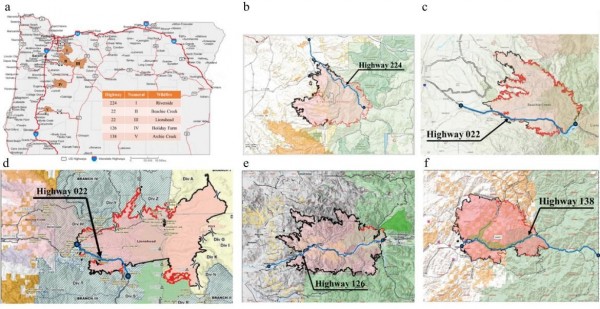Newswise — A research team examines the extent of damage and associated costs on the 2020 Labor Day wildfires in Washington, Oregon, and California, comparing with the historical impact of megafires in these states. By analyzing data from the Washington State Department of Transportation (WSDOT), Oregon Department of Transportation (ODOT), and California Department of Transportation (Caltrans), the study provides critical insights into the vulnerabilities of highway systems to wildfire events.
Megafires, defined as wildfires burning over 100,000 acres, have become increasingly common in recent decades, driven by climate change, altered land use, and human fire practices. These fires can devastate landscapes, threaten lives and property, and significantly impact transportation infrastructure. The rise of megafires has also been marked by even larger gigafires (over 100,000 hectares) and terafires (over 1,000,000 hectares), underscoring the growing challenge of wildfire management. The 2020 Labor Day wildfires in Washington, Oregon, and California caused unprecedented damage to roadways, resulting in extensive economic losses and infrastructure challenges.
A study (DOI: 10.48130/emst-0024-0016) published in Emergency Management Science and Technology on 07 August 2024, underscores the need for proactive measures, such as pre-emptive hazard tree removal and slope stabilization to reduce future repair costs.
This study assesses roadway damage from the 2020 wildfires in comparison to the history of megafires from 1902 to 2023 in Washington, 1845 to 2023 in Oregon, and 1889 to 2023 in California, focusing on the causes, extent, and impact on highway infrastructure from the 19th century to the present. The research categorizes the types of damage, including traffic control, slope-rock scaling, hazard trees, and structural impacts. The anticipated costs from the 2020 fires include over $24 million for hazard tree removal, $17.5 million for slope-rock scaling, $43 million for structural repairs, and over $3 million for traffic control, with an average repair cost of $127,783 per kilometer of impacted route.
Results showed that the 21st century has seen a dramatic increase in megafires, with Washington experiencing 71%, Oregon 64%, and California 86% of their total recorded megafires since 2000. Lightning was the primary cause, responsible for 49% of the fires, followed by human activities at 26%. Despite the extensive historical occurrence of megafires, significant roadway damage was only documented in the 21st century, primarily due to the 2020 Labor Day fires, which collectively burned over 5.4 million hectares and impacted 18 highways across the three states. California incurred the highest costs, largely due to the longer duration and greater number of megafires affecting more highways, with structural damage and slope-rock scaling being the most costly repairs. Although similar lengths of highway were affected in each state, the cost discrepancies highlight the complex relationship between fire size, frequency, and location relative to infrastructure. The study emphasizes that megafires started by lightning, though common, tend to cause the most substantial infrastructure damage compared to other causes, indicating the critical need for targeted preventive measures and improved fire management strategies.
The 2020 Labor Day wildfires exemplify the growing threat of megafires to transportation infrastructure in the western United States. By placing the damage in historical context, this study aims to inform local, state, and federal agencies about the economic and physical impacts of wildfires on highways. Enhancing data collection, improving predictive models, and increasing resilience measures are crucial steps toward mitigating future wildfire damage and protecting critical transportation networks.
###
References
DOI
10.48130/emst-0024-0016
Original Source URL
https://www.maxapress.com/article/doi/10.48130/emst-0024-0016
About Emergency Management Science and Technology
Emergency Management Science and Technology (e-ISSN 2832-448X) is an open access journal of Nanjing Tech University and published by Maximum Academic Press. It is a medium for research in the science and technology of emergency management. Emergency Management Science and Technology publishes high-quality original research articles, reviews, case studies, short communications, editorials, letters, and perspectives from a wide variety of sources dealing with all aspects of the science and technology of emergency.
